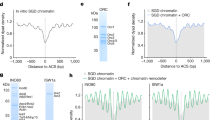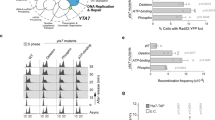Abstract
Chromatin assembly is a fundamental biological process that is essential for the replication and maintenance of the eukaryotic genome1,2,3,4. In dividing cells, newly synthesized DNA is rapidly assembled into chromatin by the deposition of a tetramer of the histone proteins H3 and H4, followed by the deposition of two dimers of histones H2A and H2B to complete the nucleosome—the fundamental repeating unit of chromatin5. Here we describe the identification, purification, cloning, and characterization of replication-coupling assembly factor (RCAF), a novel protein complex that facilitates the assembly of nucleosomes onto newly replicated DNA in vitro. RCAF comprises the Drosophila homologue of anti-silencing function 1 protein ASF16 and histones H3 and H4. The specific acetylation pattern of H3 and H4 in RCAF is identical to that of newly synthesized histones. Genetic analyses in Saccharomyces cerevisiae demonstrate that ASF1 is essential for normal cell cycle progression, and suggest that RCAF mediates chromatin assembly after DNA replication and the repair of double-strand DNA damage in vivo.
This is a preview of subscription content, access via your institution
Access options
Subscribe to this journal
Receive 51 print issues and online access
$199.00 per year
only $3.90 per issue
Buy this article
- Purchase on Springer Link
- Instant access to full article PDF
Prices may be subject to local taxes which are calculated during checkout




Similar content being viewed by others
References
Grunstein,M. Histone acetylation in chromatin structure and transcription. Nature 389, 349–352 (1997).
Kornberg,R. D. & Lorch,Y. Chromatin-modifying and -remodelling complexes. Curr. Opin. Genet. Dev. 9, 148–151 (1999).
Ito,T., Tyler,J. K. & Kadonaga,J. T. Chromatin assembly factors: a dual function in nucleosome formation and mobilization? Genes Cells 2, 593–600 (1997).
Adams,C. R. & Kamakaka,R. T. Chromatin assembly: biochemical identities and genetic redundancy. Curr. Opin. Genet. Dev. 9, 185–190 (1999).
Luger,K., Mader,A. W., Richmond,R. K., Sargent,D. R. & Richmond,T. J. Crystal structure of the nucleosome core particle at 2.8 A resolution. Nature 389, 251–260 (1997).
Le,S., Davis,C., Konopka,J. B. & Sternglanz,R. Two new S-phase specific genes from Saccharomyces cerevisiae. Yeast 13, 1029–1042 (1997).
Stillman,B. W. & Gluzman,Y. Replication and supercoiling of simian virus 40 DNA in cell extracts from human cells. Mol. Cell. Biol. 5, 2051–2060 (1985).
Stillman,B. Chromatin assembly during SV40 DNA replication in vitro. Cell 45, 555–565 (1986).
Smith,S. & Stillman,B. Purification and characterization of CAF-I, a human cell factor required for chromatin assembly during DNA replication in vitro. Cell 58, 15–25 (1989).
Tyler,J. K., Bulger,M., Kamakaka,R. T., Kobayashi,R. & Kodonaga,J. T. The p55 subunit of Drosophila chromatin assembly factor 1 is homologous to a histone deacetylase-associated protein. Mol. Cell. Biol. 16, 6149–6159 (1996).
Ito,T., Bulger,M., Pazin,M. J., Kobayashi,R. & Kadonaga,J. T. ACF, an ISWI-containing and ATP-utilizing chromatin assembly and remodeling factor. Cell 90, 145–155 (1997).
Ito,T., Bulger,M. Kobayashi,R. & Kadonaga,J. T. Drosophila NAP-1 is a core histone chaperone that functions in ATP-facilitated assembly fo regularly spaced nucleosomal arrays. Mol. Cell. Biol. 16, 3112–3124 (1996).
Ito,T., Tyler,J. K., Bulger,M., Kobayashi,R. & Kadonaga,J. T. ATP-facilitated chromatin assembly with a nucleoplasmid-like protein from Drosophila melanogaster. J. Biol. Chem. 271, 25041–25048 (1996).
Singer,M. S. et al. Identification of high-copy disruptors of telomeric silencing in Saccharomyces cerevisiae. Genetics 150, 613–632 (1998).
Spellman,P. K. et al. Comprehensive identification of cell cycle-regulated genes of the yeast Saccharomyces cerevisiae by microarray hybridization. Mol. Biol. Cell 9, 3273–3287 (1998).
Sobel,R. E., Cook,R. G., Perry,C. A., Annunziato,A. T. & Allis,C. D. Conservation of deposition-related acetylation sites in newly synthesized histones H3 and H4. Proc. Natl Acad Sci. USA 92, 1237–1241 (1995).
McIntosh,E. M. MCB elements and the regulation of DNA replication genes in yeast. Curr. Genet. 24, 185–192 (1993).
Verreault,A., Kaufman,P. D., Kobayashi,R. & Stillman,B. Nucleosome assembly by a complex of CAF-I and acetylated histones H3/H4. Cell 87, 95–104 (1996).
Kaufman,P. D., Kobayashi,R. & Stillman,B. Ultraviolet radiation sensitivity and reduction of telomeric silencing in Saccharomyces cerevisiae cells lacking chromatin assembly factor-I. Genes Dev. 11, 345–357 (1997).
Ling,X., Harkness,T. A. A., Schultz,M. C., Fisher-Adams,G. & Grunstein,M. Yeast histone H3 and H4 amino termini are important for nucleosome assembly in vivo and in vitro: redundant and position-independent functions in assembly but not in gene regulation. Genes Dev. 10, 686–699 (1996).
Gottschling,D. E., Aparicio,O. M., Billington,B. L. & Zakian,V. A. Position effect at S. cerevisiae telomeres: reversible repression of Pol II transcription. Cell 63, 751–762 (1990).
Monson,E. K., Bruin,D. de & Zakian,V. A. The yeast cac 1 protein is required for the stable inheritance of transcriptionally repressed chromatin at telomeres. Proc. Natl Acad. Sci. USA 94, 13081–13086 (1997).
Schwartz,J. L. Monofunctional alkylating agent-induced S-phase-dependent DNA damage. Mutant. Res. 216, 111–118 (1989).
Povirk,L. F. DNA damage and mutagenesis by radiomimetic DNA-cleaving agents: bleomycin, neocarzinostatin and other enediynes. Mutat. Res. 355, 71–89 (1996).
Elledge,S. J. Cell cycle checkpoints: preventing an identity crisis. Science 274, 1664–1672 (1996).
Han,M., Chang,M., Kim,U.-J. & Grunstein,M. Histone H2B repression causes cell-cycle-specific arrest in yeast: effects on chromosomal segregation, replication, and transcription. Cell 48, 589–597 (1987).
Kim,U.-J., Han,M., Kayne,P. & Grunstein,M. Effects of histone H4 deletion on the cell cycle and transcription of Saccharomyces cerevisiae. EMBO J. 7, 2211–2219 (1988).
Kamakaka,R. T., Bulger,M. & Kadonaga,J. T. Potentiation of RNA polymerase II transcription by Gal4-VP16 during but not after DNA replication and chromatin assembly. Genes Dev. 7, 1779–1795 (1993).
Acknowledgements
We thank P. Willy, D. Fyodorov, X. Huang, J. Butler, M. Levenstein, N. Dhillon, D. Donze, S. Ghidelli, L. Krushel and E. Stone for critical reading of the manuscript; L. Pillus for helpful suggestions and discussions; T. Laverty and G. Rubin for determination of the cytological location of dASF1; K. Collins for generating recombinant dASF1 protein; M. Levenstein for H3 antibodies and purified histones H3–H4; D. Allis for H4 antibodies; and R. Sternglanz, P. Kaufman, D. Shore, D. Gottschling and J. Rine for providing various strains and plasmids used in this study. This work was supported by grants from the NIH to J.T.K., R.K. and R.T.K.; J.K.T. is a Leukemia Society of America Special Fellow.
Author information
Authors and Affiliations
Corresponding author
Rights and permissions
About this article
Cite this article
Tyler, J., Adams, C., Chen, SR. et al. The RCAF complex mediates chromatin assembly during DNA replication and repair. Nature 402, 555–560 (1999). https://doi.org/10.1038/990147
Received:
Accepted:
Issue Date:
DOI: https://doi.org/10.1038/990147
This article is cited by
-
Chromatin balances cell redox and energy homeostasis
Epigenetics & Chromatin (2023)
-
Transcription and FACT facilitate the restoration of replication-coupled chromatin assembly defects
Scientific Reports (2023)
-
Signification and Application of Mutator and Antimutator Phenotype-Induced Genetic Variations in Evolutionary Adaptation and Cancer Therapeutics
Journal of Microbiology (2023)
-
TOF1 and RRM3 reveal a link between gene silencing and the pausing of replication forks
Current Genetics (2023)
-
Mechanisms of chromatin-based epigenetic inheritance
Science China Life Sciences (2022)
Comments
By submitting a comment you agree to abide by our Terms and Community Guidelines. If you find something abusive or that does not comply with our terms or guidelines please flag it as inappropriate.



